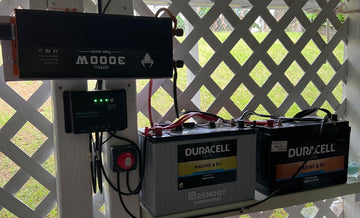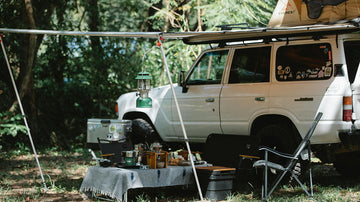Power conversion is an essential part of modern life. As the core equipment of power conversion, the choice of inverter is crucial. With so many inverter products on the market, are you feeling a little overwhelmed? Don't worry, today we're going to take a closer look at the key points to consider when buying an inverter to help you find the best inverter for your needs.
Clear needs and application scenarios
Before choosing an inverter, you should first define your needs and application scenarios. Inverters have a very wide range of applications, and in different application scenarios, inverters have to fulfill different needs.
For example, family backup power needs inverters with stable output and long endurance; camping is usually in harsh outdoor environments, which requires inverters that are lightweight, portable, waterproof, dustproof, and durable; and industrial production requires higher power and stability of inverters, which need to have enough power to support the operation of heavy machinery and equipment.
So clarifying your needs and application scenarios is the first step in choosing an inverter.
Focus on the power and efficiency of the inverter.
The power and efficiency of an inverter are important measures of its performance. Power indicates the maximum electrical power an inverter can deliver, usually measured in watts. Efficiency, on the other hand, is the ratio of the energy output to the energy input and reflects the energy lost by the inverter during the conversion process.
1. How much power do I need from an inverter?
The power of the inverter is determined by the equipment being driven. The power of the inverter should meet the total power requirements of the connected equipment, including the rated and peak power of the equipment.
The power rating can usually be found on the equipment or in the operating instructions. Some equipment may require a higher instantaneous power when starting or running, this is the peak power demand of the equipment. Ensure that the power rating of the inverter covers the peak power requirements of all the equipment.
Here's a simple estimate: first list the power ratings of the equipment you need, then add them up. In addition to the resulting total power, add a certain power margin (usually 10-20%) to get the power range of the required inverter. For example, if you need to power a small fan (about 40W), a laptop (about 10W), and an LED light (about 20W), the required power would be about (40+10+20)*1.2 = 84W.
Inverter conversion efficiency
The conversion efficiency of an inverter usually depends on the type, brand, and quality of the inverter. In general, the efficiency of inverters ranges from 85% to 98%. The more efficient the inverter, the less energy is lost and the lower the running costs. However, there is no such thing as a 100% efficient inverter. The highest efficiency is usually achieved with inverters in 15% to 60% of rated output power. Efficiency drops rapidly below 15%, so don't buy an inverter much bigger than you need.
The inverter's conversion efficiency is 85% based on the previous example. Then the power of the inverter to supply the device should be 84W/0.85 = 98.8W. So you need a 100-watt inverter!
2. Commonly used electronic equipment wattage list
| Device name | Rated power (W) |
| Laptop computer | 60-100 |
| Cell phone charger | 5-20 |
| Tablet PC | 10-30 |
| Digital camera | 5-15 |
| Small electric fan | 20-50 |
| LED lights | 5-20 |
| Blender | 500-1000 |
Just so you know, the above data is for reference only, and the power of specific devices may vary.
Pay attention to the waveform and stability of the inverter
There are two main types of inverter output: modified sine wave and pure sine wave. The waveform and stability of the inverter have a major impact on the effectiveness and longevity of the equipment. A quality inverter should be able to provide a stable sine wave output to ensure the normal operation of the equipment.
1. Common Inverter Waveforms
Modified sine wave: Modified Sine Wave inverter output waveform is close to Sine Wave, but there is a certain amount of distortion. The diagram below shows one of the simplest forms of corrected sine waves. Sharp rises and falls in voltage can cause problems in some applications, such as interference with TV pictures, hum from audio equipment, and even overheating of transformers and gadget chargers. This waveform is suitable for equipment that does not require a high waveform, such as electric fans, drills, blenders, hair dryers, curling tongs, simple battery chargers, etc.
Generating this type of waveform is simpler and less expensive. As a result, corrected sine wave inverters are often economical and suitable for many residential and commercial applications.

Pure sine wave: The waveform produced by a pure sine wave inverter should be very similar in shape and characteristics to the waveform of the power supplied by the utility company and can therefore be used safely for any type of load. For sensitive equipment (communications equipment, medical equipment, audio equipment), a pure sine wave inverter is the best choice.
Pure sine wave inverters cost more. If you are on a budget, consider buying a small inverter for sensitive items and a larger modified sine wave inverter for everything else.
2. Difference between Modified Sine Wave and Pure Sine Wave
| Comparison Item | Modified Sine Wave | Pure Sine Wave |
| Waveform Characteristics | Distortion and ripple, discontinuous waveform | Smooth and continuous waveform, no distortion or ripple |
| Harmonic Distortion | Around 20% | Very low or none |
| Application Scenario | Household appliances, travel or field backup power | High-performance, high-precision equipment |
| Conversion Efficiency | Between 80% and 90% | Above 90% (peak) |
| Cost | Relatively low | Relatively high |
| Device Compatibility | Most household appliances, are not suitable for precision equipment | Compatible with any electrical equipment |
| Stability and Durability | May reduce equipment lifespan | Conducive to stable equipment operation |
| Noise | May produce some noise | Low noise, smooth operation |
Please note that this table is a simplified representation, and the actual performance of inverter products may vary depending on the specific brand and model. When purchasing, it is recommended to carefully review product specifications and performance parameters to choose the inverter that best suits your needs.
3. Pure Sine Wave Inverter or Modified Sine Wave Inverter?
In summary, there is a clear difference between a pure sine wave inverter and a modified sine wave inverter. Pure sine wave inverters have high-quality output waveforms, stable electrical performance, and a wide range of applications that can meet the power supply requirements of most equipment. On the other hand, the output waveform quality of the modified sine wave inverter is poor, the efficiency is relatively low, and the scope of application is limited. Therefore, when choosing an inverter, it is necessary to choose according to the specific application needs and equipment requirements.
Choose the right battery for the inverter
Inverters need batteries as energy support. When choosing batteries, consider factors such as battery capacity, voltage, and type. Generally speaking, the larger the battery capacity, the longer the range of the inverter; the battery voltage should be matched with the inverter to ensure the normal operation of the inverter.
Battery type:
Lead-acid batteries
Inverters use a lot of DC power over some time. Therefore, the best type of battery to power an inverter is a deep-cycle battery. Lead-acid batteries are typically designed to be repeatedly deep discharged to about 50% of their nominal capacity and then recharged.AGM lead-acid batteries are ideal for use with inverters. This is because they are designed with an absorbent glass fiber mat, which helps to reduce the internal resistance of the battery. The low internal resistance helps the current flow more smoothly and improves the charging and discharging efficiency of the battery.

If you are on a budget, choosing lithium-ion batteries for your inverter is an advanced and efficient option. Then buy them. Lithium-ion batteries can be repeatedly discharged to around 20% capacity and recharged very quickly, which is particularly useful for RVs and campers that can use an alternator. Lithium-ion batteries typically have a long cycle life and multiple charge and discharge cycles do not significantly degrade performance.

To learn more about the differences between lithium and lead acid batteries. See our guide to batteries here for more information.
In conclusion, choosing an inverter that best suits your needs requires consideration of several factors. Defining the needs and application scenarios, paying attention to the power and efficiency of the inverter, judging the power of the required inverter, paying attention to the waveform and stability of the inverter, and choosing the right battery for the inverter are all important aspects to consider when choosing an inverter. We hope this article can provide you with some useful references when choosing an inverter.













